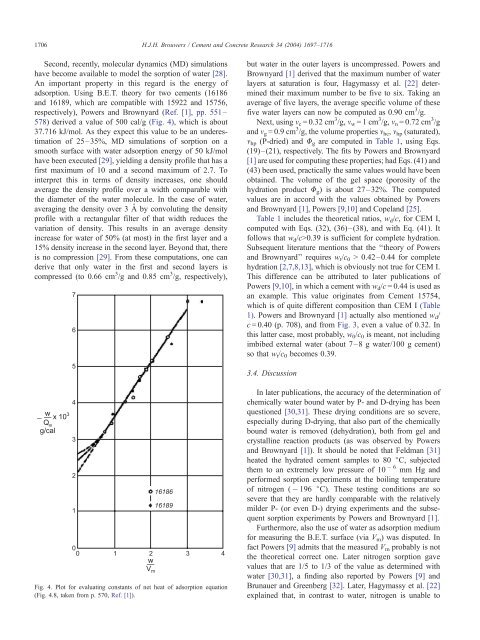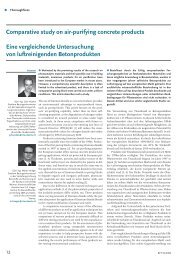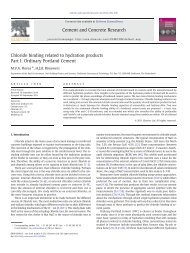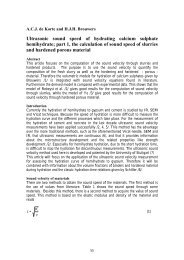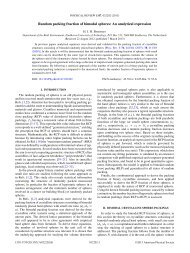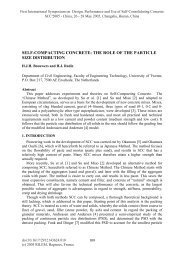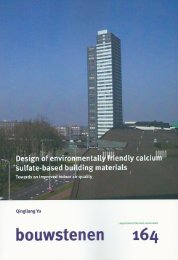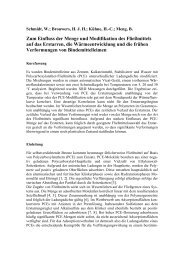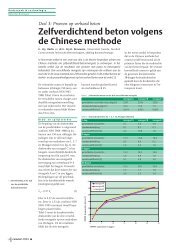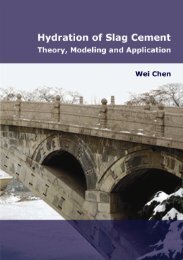1706H.J.H. <strong>Brouwers</strong> / Cement <strong>and</strong> Concrete Research 34 (2004) 1697–1716Second, recently, molecular dynamics (MD) simulationshave become available to model the sorption <strong>of</strong> water [28].An important property in this regard is the energy <strong>of</strong>adsorption. Using B.E.T. theory for two cements (16186<strong>and</strong> 16189, which are compatible with 15922 <strong>and</strong> 15756,respectively), <strong>Powers</strong> <strong>and</strong> <strong>Brownyard</strong> (Ref. [1], pp. 551–578) derived a value <strong>of</strong> 500 cal/g (Fig. 4), which is about37.716 kJ/mol. As they expect this value to be an underestimation<strong>of</strong> 25–35%, MD simulations <strong>of</strong> sorption on asmooth surface with water adsorption energy <strong>of</strong> 50 kJ/molhave been executed [29], yielding a density pr<strong>of</strong>ile that has afirst maximum <strong>of</strong> 10 <strong>and</strong> a second maximum <strong>of</strong> 2.7. Tointerpret this in terms <strong>of</strong> density increases, one shouldaverage the density pr<strong>of</strong>ile over a width comparable withthe diameter <strong>of</strong> the water molecule. In the case <strong>of</strong> water,averaging the density over 3 Å by convoluting the densitypr<strong>of</strong>ile with a rectangular filter <strong>of</strong> that width reduces thevariation <strong>of</strong> density. This results in an average densityincrease for water <strong>of</strong> 50% (at most) in the first layer <strong>and</strong> a15% density increase in the second layer. Beyond that, thereis no compression [29]. From these computations, one c<strong>and</strong>erive that only water in the first <strong>and</strong> second layers iscompressed (to 0.66 cm 3 /g <strong>and</strong> 0.85 cm 3 /g, respectively),but water in the outer layers is uncompressed. <strong>Powers</strong> <strong>and</strong><strong>Brownyard</strong> [1] derived that the maximum number <strong>of</strong> waterlayers at saturation is four, Hagymassy et al. [22] determinedtheir maximum number to be five to six. Taking anaverage <strong>of</strong> five layers, the average specific volume <strong>of</strong> thesefive water layers can now be computed as 0.90 cm 3 /g.Next, using m c = 0.32 cm 3 /g, m w =1cm 3 /g, m n = 0.72 cm 3 /g<strong>and</strong> m g = 0.9 cm 3 /g, the volume properties m hc , m hp (saturated),m hp (P-dried) <strong>and</strong> U g are computed in Table 1, using Eqs.(19)–(21), respectively. <strong>The</strong> fits by <strong>Powers</strong> <strong>and</strong> <strong>Brownyard</strong>[1] are used for computing these properties; had Eqs. (41) <strong>and</strong>(43) been used, practically the same values would have beenobtained. <strong>The</strong> volume <strong>of</strong> the gel space (porosity <strong>of</strong> thehydration product U g ) is about 27–32%. <strong>The</strong> computedvalues are in accord with the values obtained by <strong>Powers</strong><strong>and</strong> <strong>Brownyard</strong> [1], <strong>Powers</strong> [9,10] <strong>and</strong> Copel<strong>and</strong> [25].Table 1 includes the theoretical ratios, w d /c, for CEM I,computed with Eqs. (32), (36)–(38), <strong>and</strong> with Eq. (41). Itfollows that w d /c>0.39 is sufficient for complete hydration.Subsequent literature mentions that the ‘‘theory <strong>of</strong> <strong>Powers</strong><strong>and</strong> <strong>Brownyard</strong>’’ requires w t /c 0 > 0.42–0.44 for completehydration [2,7,8,13], which is obviously not true for CEM I.This difference can be attributed to later publications <strong>of</strong><strong>Powers</strong> [9,10], in which a cement with w d /c = 0.44 is used asan example. This value originates from Cement 15754,which is <strong>of</strong> quite different composition than CEM I (Table1). <strong>Powers</strong> <strong>and</strong> <strong>Brownyard</strong> [1] actually also mentioned w d /c = 0.40 (p. 708), <strong>and</strong> from Fig. 3, even a value <strong>of</strong> 0.32. Inthis latter case, most probably, w 0 /c 0 is meant, not includingimbibed external water (about 7–8 g water/100 g cement)so that w t /c 0 becomes 0.39.3.4. DiscussionFig. 4. Plot for evaluating constants <strong>of</strong> net heat <strong>of</strong> adsorption equation(Fig. 4.8, taken from p. 570, Ref. [1]).In later publications, the accuracy <strong>of</strong> the determination <strong>of</strong>chemically water bound water by P- <strong>and</strong> D-drying has beenquestioned [30,31]. <strong>The</strong>se drying conditions are so severe,especially during D-drying, that also part <strong>of</strong> the chemicallybound water is removed (dehydration), both from gel <strong>and</strong>crystalline reaction products (as was observed by <strong>Powers</strong><strong>and</strong> <strong>Brownyard</strong> [1]). It should be noted that Feldman [31]heated the hydrated cement samples to 80 jC, subjectedthem to an extremely low pressure <strong>of</strong> 106 mm Hg <strong>and</strong>performed sorption experiments at the boiling temperature<strong>of</strong> nitrogen ( 196 jC). <strong>The</strong>se testing conditions are sosevere that they are hardly comparable with the relativelymilder P- (or even D-) drying experiments <strong>and</strong> the subsequentsorption experiments by <strong>Powers</strong> <strong>and</strong> <strong>Brownyard</strong> [1].Furthermore, also the use <strong>of</strong> water as adsorption mediumfor measuring the B.E.T. surface (via V m ) was disputed. Infact <strong>Powers</strong> [9] admits that the measured V m probably is notthe theoretical correct one. Later nitrogen sorption gavevalues that are 1/5 to 1/3 <strong>of</strong> the value as determined withwater [30,31], a finding also reported by <strong>Powers</strong> [9] <strong>and</strong>Brunauer <strong>and</strong> Greenberg [32]. Later, Hagymassy et al. [22]explained that, in contrast to water, nitrogen is unable to
H.J.H. <strong>Brouwers</strong> / Cement <strong>and</strong> Concrete Research 34 (2004) 1697–1716 1707enter all pores. For their pycnometer experiments, <strong>Powers</strong><strong>and</strong> <strong>Brownyard</strong> (Ref. [1], pp. 692–694) also discussedcritically various displacement media, being aware that somespace might be inaccessible to inert gases <strong>and</strong>/or largermolecules.For determining the total retained water, i.e., nonevaporableplus gel water, the methods <strong>of</strong> <strong>Powers</strong> <strong>and</strong> <strong>Brownyard</strong>[1] presented in this section are very useful. <strong>The</strong>y are based ona large number <strong>of</strong> carefully executed experiments, wherebythe combination <strong>of</strong> relatively mild P-drying <strong>and</strong> water asabsorption medium provide valuable results, although it isvery likely that part <strong>of</strong> the gel water is actually chemicallybound (especially for the crystalline hydration products)while the other part is adsorbed (in the C-S-H). However,the total <strong>of</strong> nonevaporable plus gel water still comprises thetotal retained water. In this respect, the significant fact that gelwater <strong>and</strong> nonevaporable water are directly related is also aremarkable <strong>and</strong> very useful result. Furthermore, the significance<strong>and</strong> magnitude <strong>of</strong> gel water (i.e., being 4V m ) wereindependently confirmed by freezing/thaw experiments by<strong>Powers</strong> <strong>and</strong> <strong>Brownyard</strong> (Ref. [1], pp. 959–968).<strong>The</strong> P-drying method <strong>and</strong> quantification <strong>of</strong> w n /c is veryuseful to determine the degree <strong>of</strong> hydration. This is thereason why V m <strong>and</strong> w g can be related to w n . It has alsobecome clear that the concept <strong>of</strong> nonevaporable <strong>and</strong> gelwater is useful for determining the chemical shrinkage <strong>of</strong> thesystem per mass <strong>of</strong> reacted cement, as is related to w n /c <strong>and</strong>w g /c. Furthermore, the model <strong>of</strong> <strong>Powers</strong> <strong>and</strong> <strong>Brownyard</strong> [1]makes a clear distinction, on one h<strong>and</strong>, between nonevaporable<strong>and</strong> gel water, <strong>and</strong> on the other, capillary pore water(see also Fig. 3). That the measured B.E.T. surface usingwater is approximate (at least) is not relevant for the amount<strong>of</strong> retained gel water either. <strong>The</strong> proportionality with theamount <strong>of</strong> gel water is already a useful result. <strong>The</strong> amount<strong>of</strong> gel water is relevant, <strong>and</strong> an alternative B.E.T. surfacewill only result in a modification <strong>of</strong> the number <strong>of</strong> absorbedlayers; for example, it would be larger than four if thissurface is reduced <strong>and</strong> vice versa.Summarising, although the meaning <strong>of</strong> some measuredchemical <strong>and</strong> physical properties might be disputed, theoverall measured amounts <strong>of</strong> nonevaporable <strong>and</strong> gel waterare very useful to obtain total retained water, gel porosity,<strong>and</strong> can be used to assess shrinkage <strong>and</strong> the prevailingchemical reactions <strong>of</strong> the individual clinker phases. To thisend, the water retention in P-dried <strong>and</strong> saturated states willbe used in the next section to study the hydration <strong>of</strong> thecalcium silicate phases. In a forthcoming publication, thehydration reactions <strong>of</strong> the three other phases are examined[15]. Furthermore, the information on the specific volume <strong>of</strong>the compressed water will be used to quantify the porosity<strong>and</strong> density <strong>of</strong> the C-S-H. Note that the approach by <strong>Powers</strong><strong>and</strong> <strong>Brownyard</strong> [1], also followed here, relates the waterbinding by hydration products formed from the reacted four(here, five) major clinker phases. <strong>The</strong>se clinker phasescomprise the major oxides C, S, A, F <strong>and</strong> S¯. Implicitly,their approach prevents the remaining minor oxides (thealkalis, MgO etc.) from combining with water. This impliesthat upon the reaction <strong>of</strong> the cement, these oxides enter thehydration product without mass increase. As x RO is usuallysmall (e.g., see Table 1), this approach is allowed.4. Reactions <strong>of</strong> calcium silicate phases<strong>Powers</strong> <strong>and</strong> <strong>Brownyard</strong> [1] presented a literature review<strong>of</strong> the reactions products <strong>and</strong> were aware that the products<strong>of</strong> the clinker phases C 3 S <strong>and</strong> C 2 S were ‘‘microcrystalline’’CH <strong>and</strong> a ‘‘colloidal gel’’, also named ‘‘colloidal hydroussilicate’’ <strong>and</strong> ‘‘calcium silicate hydrate’’ (pp. 106–132, 260<strong>and</strong> 488). In later <strong>work</strong>, this product was called ‘‘tobermoritegel’’ [23,32–35], <strong>and</strong> nowadays, it is generally called C-S-H [2]. It is known to be a poorly crystalline to almostamorphous material.Both calcium silicate phases <strong>and</strong> said reaction productsare abundant in cement paste, <strong>and</strong> here, the reactions thattake place in case other clinker phases are absent arediscussed. By <strong>Brouwers</strong> [15], the reaction in combinationwith ferrite phase is addressed. Accordingly, here, thefollowing relations are put forward:C 2 S þð2 x þ yÞ H ! C x SH y þð2 xÞ CH; ð45ÞC 3 S þð3 x þ yÞ H ! C x SH y þð3 xÞ CH: ð46ÞNote that at that time x, the C/S ratio was unknown,although it was known that the C 2 S reaction hardly producesCH (Ref. [1], p. 488). In other words, x should be close to 2,being in agreement with the present knowledge <strong>of</strong> x being inthe range 1.5 to 2. <strong>The</strong> C/S ratio depends, among others, onthe hydration conditions (bottle, paste), particle size, age<strong>and</strong> the analytical method employed [2].Eq. (46) was proposed by Locher [12], who was the first tocouple the overall nonevaporable water <strong>of</strong> Portl<strong>and</strong> cement(thus, not C 3 S in particular), as determined by the method by<strong>Powers</strong> <strong>and</strong> <strong>Brownyard</strong> [1], to the hydration <strong>of</strong> C 3 S.Note that (2 x + y) <strong>and</strong> (3 x + y) correspond to n H , <strong>and</strong>that n C2 S = 1 <strong>and</strong> n C2 S = 1 in Eqs. (45) <strong>and</strong> (46), respectively.<strong>The</strong> value <strong>of</strong> n H depends on the drying conditions (see Eqs.(35) <strong>and</strong> (42) for their values in P-dried <strong>and</strong> saturated states,respectively).4.1. P-dried stateBased on the findings <strong>of</strong> Brunauer <strong>and</strong> Greenberg [32],Brunauer et al. [33] <strong>and</strong> Kantro et al. [35], P-drying onlyremoves water from the C-S-H but not from CH, <strong>and</strong> it doesnot affect the C/S (x) ratio <strong>of</strong> the C-S-H.X-ray analysis on P-dried C 2 S <strong>and</strong> C 3 S/alite by Kantro etal. [35] revealed that (x y) amounts to 0.5 <strong>and</strong> 0.4 in C-S-H formed by C 2 S <strong>and</strong> C 3 S/alite, respectively. <strong>The</strong>se valuesare stable up to 1700 days for water–cement ratios rangingfrom 0.45 to 0.7. From Eq. (35), it follows n C2 S = 1 <strong>and</strong>n H,n = 1.51 for the C 2 S reaction, thus, (x y) equals 0.49.


